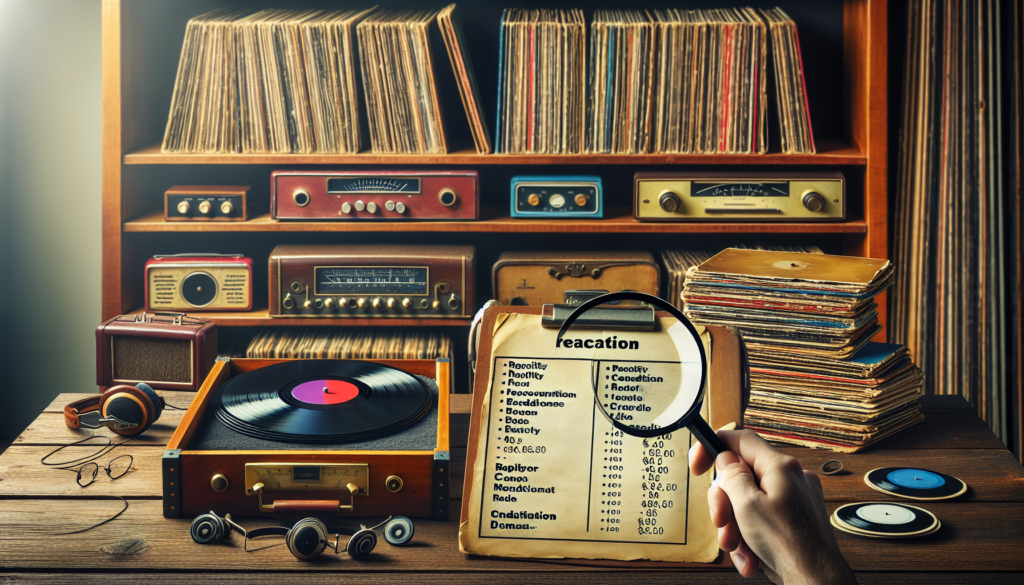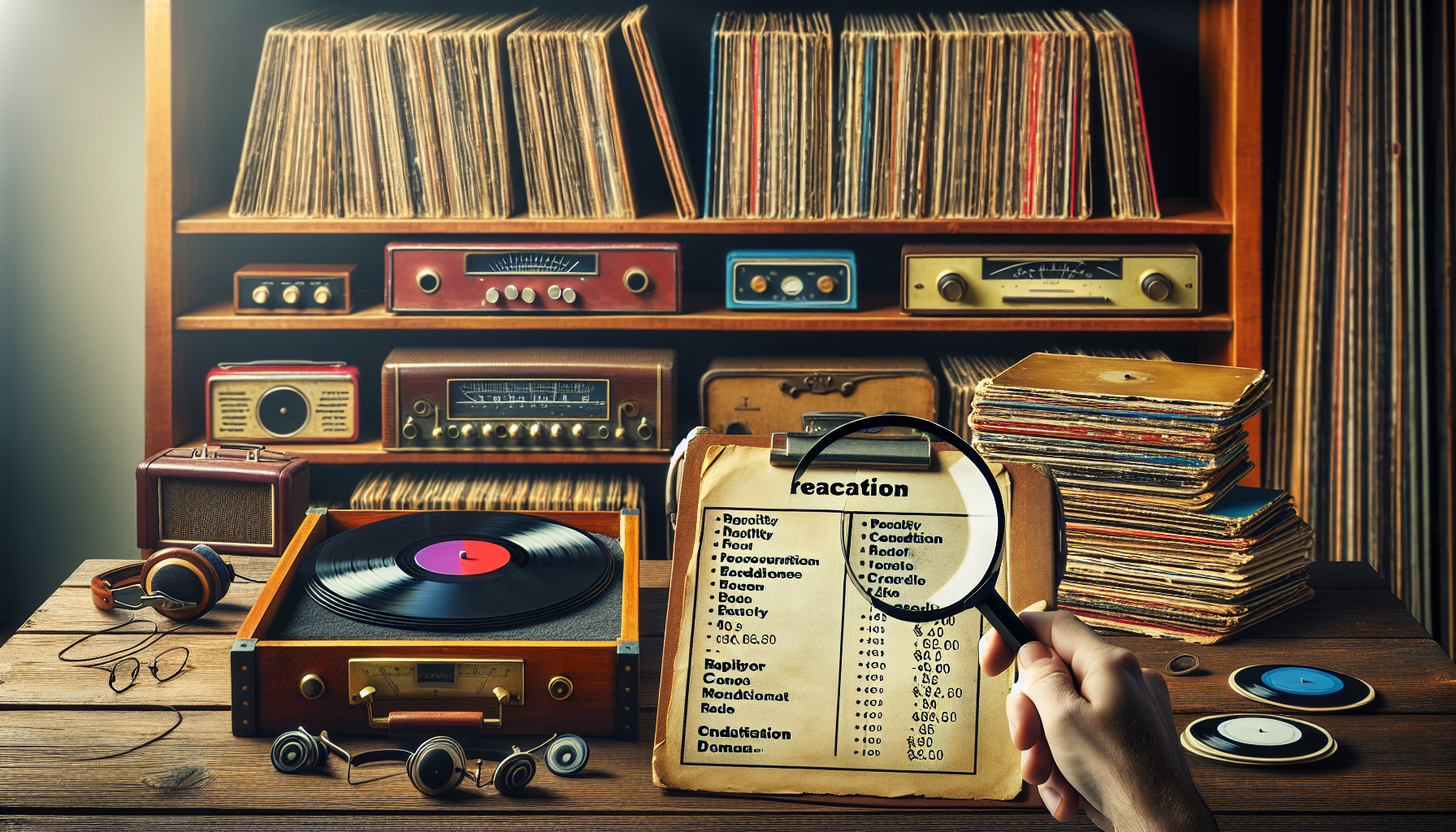Have you ever wondered if those old vinyl records gathering dust in your attic are actually worth something? Well, wonder no more! In this article, we will explore the various factors that determine the value of vinyl records, helping you determine whether you’re sitting on a hidden treasure or just a collection of nostalgic tunes. Get ready to uncover the secrets of vinyl record valuation and discover the potential worth of your beloved music collection.

Physical Condition
Visual inspection
When determining the value of your vinyl records, the first step is to visually inspect their physical condition. Examine the record for any visible signs of wear and tear, such as scratches, scuffs, or warping. If the vinyl appears to be in pristine condition, it will likely have a higher value compared to records with noticeable damage.
Surface condition
The surface condition of a vinyl record refers to the overall smoothness and cleanliness of the playing surface. The presence of dust, fingerprints, or other contaminants can affect the sound quality and decrease the value of the record. Additionally, deep scratches on the surface can cause skips or jumps during playback, making the record less desirable to collectors.
Sleeve condition
The condition of the record’s sleeve, which is the protective cover that houses the vinyl, is also an important factor in determining its value. Look for any signs of wear, such as creases, tears, or staining. A well-preserved sleeve can significantly enhance the value of the record, especially if it features original artwork or design elements that are associated with a particular artist or time period.
Presence of inserts or extras
Some vinyl records may come with inserts or additional features that can increase their value. These extras can include lyric sheets, posters, original inner sleeves, or bonus tracks. If your record includes any of these additional elements and they are in good condition, it can add to its overall value and desirability among collectors.
Label Information
Label variation
Label variations refer to different versions of a record that were released by different record labels or at different times. Different labels may have different designs, logos, or catalog numbers, which can impact the value of the record. Some collectors may have a preference for specific label variations, especially if they are associated with a certain time period or have historical significance.
Promotional copies
Promotional copies of vinyl records are often distributed to radio stations, music industry professionals, or journalists to generate buzz and promote an upcoming release. These promotional copies may have unique markings, such as “promo” stamps or stickers, and are typically considered more valuable due to their limited availability.
Errors or misprints
Vinyl records with errors or misprints can be highly sought after by collectors. These errors can range from small typographical mistakes on the record label to more significant manufacturing errors that affect the sound quality or playability of the record. If you come across a record with a known error or misprint, it may have increased value among collectors who appreciate these unique quirks.
Scarcity or Rarity
Limited releases
Limited releases are vinyl records that were intentionally produced in limited quantities, often to create exclusivity or enhance their collectibility. These limited editions can include special color variants, unique packaging, or bonus tracks. The scarcity of these records makes them more valuable among collectors who are eager to add rare items to their collections.
Small pressings
Vinyl records that were produced in small pressings, typically from independent or niche record labels, can also be highly valuable. These records may have limited distribution and are often associated with underground or lesser-known artists. The fact that they were released in small quantities makes them rare and sought after by collectors who appreciate the authenticity and uniqueness of these recordings.
Regional or country-specific releases
Vinyl records that were released in specific regions or countries can have increased value due to their limited availability. For example, a record that was only released in Japan or in a certain city can be highly sought after by collectors who want to complete their regional collections. These records often have distinctive features or artwork that are unique to their specific release location.
Test pressings
Test pressings are early vinyl records that are produced in limited quantities for quality control purposes. These records are typically made before the final production run and may not have finalized artwork or packaging. Due to their limited availability and the fact that they are often the first physical copies of a release, test pressings can be highly valuable to collectors interested in owning a piece of the recording process.
Pre-production or demo versions
Vinyl records that were produced as pre-production or demo versions also hold significant value in the collectors’ market. These versions are often released in limited quantities to generate interest and secure a record deal. They may feature alternate mixes, unfinished songs, or unique artwork, making them highly desirable for collectors who want to delve into the creative process behind an album.
Artist and Album
Popularity and demand
The popularity and demand surrounding a particular artist or album are important factors in determining the value of vinyl records. Artists who have a large and dedicated fan base, as well as albums that have achieved commercial success or critical acclaim, are more likely to have valuable records. The demand for these records drives up their value in the collectors’ market.
Significance and influence
Vinyl records that have had a significant impact on the music industry or on specific genres can also be highly valuable. These records may have pioneered new styles or influenced other artists and movements. Examples include albums that marked a turning point in an artist’s career, defined a genre, or introduced groundbreaking production techniques. The historical and cultural significance of these records increases their desirability among collectors.
First or early pressings
First or early pressings of vinyl records are often more valuable than later reissues or repressings. These initial pressings, which were usually released around the time of the album’s original release date, are considered more authentic and collectible. They often feature unique characteristics, such as original mixes, mastering differences, or artwork variations, which distinguish them from subsequent reissues.
Unreleased or cancelled albums
Vinyl records of unreleased or cancelled albums can hold significant value due to their rarity and the intrigue surrounding them. These records may include albums that were shelved by record labels, unfinished projects, or bootleg recordings of live performances. Collectors who are interested in the artists’ discography or in uncovering hidden musical gems are often willing to pay a premium for these rare and exclusive records.
Sales and Discography
Sales history
The sales history of a vinyl record can provide valuable insights into its value. Records that have sold well in the past, either during their original release or through subsequent reissues, are likely to have a higher value in the collectors’ market. The demand for these records is driven by their commercial success and popularity among music enthusiasts.
Chart performance
Vinyl records that have achieved high chart positions, such as reaching the top of the Billboard charts or appearing on influential music magazines’ rankings, can significantly impact their value. Chart success indicates the popularity and commercial viability of an album, making it more desirable among collectors who seek records that have had a wide cultural impact.
Discography and catalog number
The overall discography of an artist, as well as the catalog number of a specific release, can influence the value of vinyl records. Certain albums or phases in an artist’s career may be highly sought after, such as debut albums, breakthrough records, or albums that marked a significant stylistic departure. Furthermore, records with lower catalog numbers, especially those from iconic record labels, are often considered more valuable due to their early or limited release status.
Official reissues or remasters
The value of vinyl records can also be affected by official reissues or remasters. When a record label releases a new version of an album, either to commemorate a milestone anniversary or to improve the sound quality through remastering, it can impact the value of earlier pressings. In some cases, collectors may prefer the original pressings, which can increase their value, while in other cases, the official reissue may become the more desirable version due to improved sound quality or additional bonus content.
Genre and Musical Trends
Sought-after genres or subgenres
Certain genres or subgenres of music are highly sought after by vinyl collectors, which can affect the value of records in those genres. For example, genres like jazz, funk, soul, and punk have dedicated fan bases that actively seek out rare and valuable vinyl records. Additionally, specific subgenres or movements within these genres, such as psychedelic rock, acid jazz, or post-punk, may have their own collectors’ markets and command higher prices.
Influential movements or scenes
Vinyl records associated with influential musical movements or scenes often have increased value among collectors. These records capture specific moments in music history and are often considered essential pieces in a comprehensive music collection. Examples include records from the British Invasion, the Motown era, the New York punk scene, or the rise of electronic music. The historical and cultural significance of these records make them highly desirable and valuable.
Collectors’ Market
Current market trends
The value of vinyl records can fluctuate over time due to current market trends. Certain genres or artists may experience periods of increased popularity or renewed interest, which drives up the prices of their records. Additionally, collectors’ preferences and tastes can shift, leading to increased demand for certain records and subsequent increases in their value. Staying informed about the current market trends can help you assess the potential value of your vinyl records.
Collector interest
The level of interest among vinyl collectors can significantly impact the value of records. If an album or artist is highly sought after by collectors, the prices for their records may skyrocket. Factors that contribute to collector interest include rarity, artistic appeal, historical significance, and personal connections to the music. Collectors who are passionate about specific artists, genres, or musical eras are more likely to be willing to pay a premium for rare or desirable records.
Auction prices and sales history
Monitoring auction prices and sales history can provide valuable insights into the value of vinyl records. Auctions, both online and in-person, often attract serious collectors who are willing to pay top dollar for rare or highly coveted records. By researching the prices that similar records have sold for in the past, you can gauge the potential value of your own vinyl collection. Online marketplaces, record stores, and specialized vinyl collecting communities can also provide helpful data on sales history.
Professional Appraisals and Research
Consulting experts
If you are unsure about the value of your vinyl records, consulting with experts in the field can provide clarity. Professional appraisers or reputable record dealers can assess the condition and rarity of your records and provide an estimated value. They have the expertise and knowledge to identify rare or collectible records and can help you navigate the complex world of vinyl collecting.
Online resources
The internet is a valuable resource for researching the value of vinyl records. Numerous websites and online forums dedicated to vinyl collecting provide information on specific releases, price guides, and discussions on the collectors’ market. These online resources can help you identify the key factors that impact the value of vinyl records and guide you through the process of determining their worth.
Discogs database
Discogs, a popular online music database and marketplace, is an invaluable tool for cataloging and researching vinyl records. It allows users to create a detailed inventory of their collections, including information on the condition, pressing details, and marketplace prices. The extensive catalog of vinyl releases and the vast community of collectors on Discogs make it an excellent resource for assessing the value of your records.
Condition Grading
Mint condition
Vinyl records in mint condition are considered the highest grade and are highly sought after by collectors. Mint records are essentially brand new, with no signs of wear, scratches, or other imperfections that could impact their sound quality. They often come in their original shrink wrap or protective sleeves and have never been played or handled extensively.
Near mint
Vinyl records in near mint condition are also highly coveted by collectors. These records have minimal signs of wear, such as faint sleeve marks or hairline scratches that do not affect the sound quality. Near mint records are well-preserved and carefully handled, and they often come with their original sleeves and inserts, maintaining their value and desirability.
Very good
Very good condition records show more signs of wear and use compared to those in mint or near mint condition. They may have light surface marks, some visible scratches, or signs of aging on the sleeve. However, these imperfections do not significantly affect the sound quality or playability of the record. Very good condition records are still considered valuable, especially if they are rare or in high demand.
Good
Good condition records have more noticeable signs of wear and play, such as surface scratches, scuffs, or staining. While these imperfections may affect the sound quality or cause some noise during playback, the record is still playable. Good condition records are typically less valuable than those in mint or near mint condition but can still be desirable to collectors who are willing to accept some level of wear.
Fair or poor condition
Vinyl records in fair or poor condition have extensive signs of wear, including deep scratches, warped surfaces, or significant damage to the sleeve. These records may have audible pops, crackles, or skips during playback, which greatly diminish the listening experience. Fair or poor condition records have minimal value to collectors, unless they are exceptionally rare or have historical significance.
Distinguishing Features
Colored vinyl
Vinyl records pressed on colored vinyl can add to their value and desirability among collectors. The use of colored vinyl, whether in solid colors or special color variants, creates a visually appealing and unique record. Collectors often seek out records with distinct colors, such as transparent, marbleized, or picture disc vinyl, as they can enhance the visual and aesthetic experience of owning and displaying vinyl records.
Picture discs
Picture discs are vinyl records that feature images or artwork printed directly onto the playing surface instead of traditional black vinyl. These visually striking records can depict album covers, band logos, or custom designs. Picture discs are often considered more collectible due to their unique aesthetic appeal, but it is worth noting that the sound quality of picture discs can sometimes be compromised due to the additional manufacturing process.
Limited edition packaging
Vinyl records with limited edition packaging, such as deluxe box sets, unique sleeves, or special inserts, can command higher prices among collectors. These records often include additional artwork, booklets, posters, or other exclusive content that enhances the overall package. Limited edition packaging adds a sense of exclusivity and collectibility to the record, making it more desirable to collectors who appreciate unique and well-crafted presentations.
Gatefold sleeves
Gatefold sleeves are record sleeves that fold out, featuring a larger surface area for artwork or additional content. These sleeves provide a visually striking presentation and are often used for concept albums, double LPs, or records with elaborate artwork. Vinyl records with gatefold sleeves are considered more valuable due to the enhanced aesthetic appeal and the added collectible factor of having a unique packaging design.
Autographs or personalizations
Vinyl records that are autographed by the artist or individuals associated with the recording can significantly increase their value. Autographed records provide a personal connection to the artist and add an extra layer of authenticity to the record. Collectors often seek out signed records, especially if they include personalized messages or rare signatures. However, it is important to authenticate autographs to ensure their legitimacy and maximize the value of the record.
Determining the value of vinyl records involves considering various factors, including the physical condition of the record and sleeve, the rarity and desirability of the release, the popularity and influence of the artist and album, the sales and chart performance, and the broader trends in the vinyl collectors’ market. Consulting experts, conducting research, and leveraging online resources like the Discogs database can provide valuable insights into the value of your vinyl collection. By understanding these factors and carefully assessing your vinyl records, you can confidently determine their worth and potentially uncover valuable gems within your collection.

